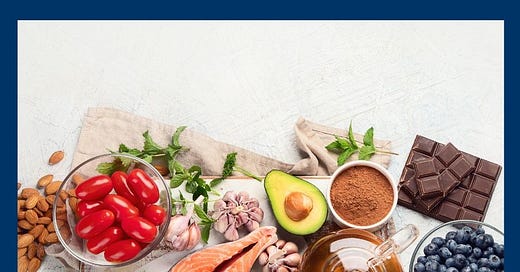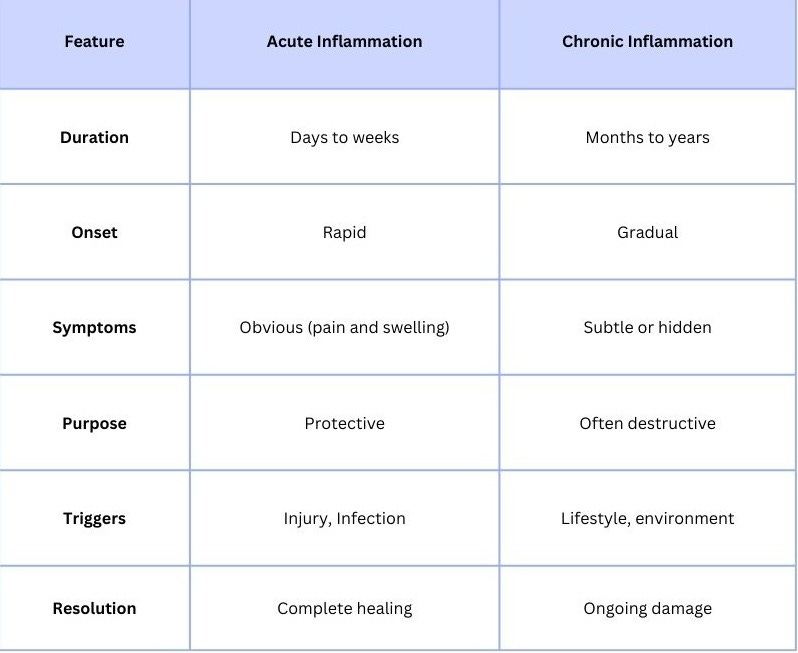Have you ever wondered why some people seem to stay vibrant and full of life as they age? One key factor might be what they’re eating.
Chronic inflammation, often fueled by diet, is a major contributor to how we age. It’s not just about wrinkles or achy joints; inflammation plays a role in almost every aspect of health from heart disease to cognitive decline.
While we can’t stop the clock, research shows that how we age has less to do with time itself and more to do with inflammation. The best part? Unlike the number of birthday candles on your cake, chronic inflammation doesn’t have to be an inevitable part of growing older. You have the power to fight it, starting with what’s on your plate.
What Is Inflammation and Why Does It Matter?
Chronic inflammation is a persistent, low-grade condition that plays a crucial role in aging and disease development. Imagine your body as a highly sophisticated security system. When it detects a threat—whether it’s an injury, infection, or toxic substance—it launches an inflammatory response, much like security personnel responding to an alarm. This acute inflammation is protective and necessary, characterized by familiar signs like redness, swelling, and pain when you sprain your ankle or get a cut.
However, chronic inflammation is different. It’s like having that security system stuck in “alert” mode, continuously deploying resources even when there’s no immediate threat. This persistent inflammatory state can damage healthy tissues over time, much like the way a constantly running engine eventually wears down.
Poor dietary choices, stress, lack of exercise, and even environmental factors can all contribute to a constant low-grade state of inflammation that accelerates aging and increases your risk of chronic diseases.
Acute vs. Chronic Inflammation: Key Differences
What is Inflammaging?
Think of inflammaging as your body’s “wear and tear” alarm system that gets more sensitive as you age. Just like an older car might start making more noise and requiring more maintenance, your body can start producing more inflammatory signals over time.
Inflammaging is a term used to describe the chronic, low-grade inflammation associated with aging. Over time, this persistent inflammation can damage tissues, organs, and cells, accelerating the aging process and increasing the likelihood of age-related diseases such as arthritis, diabetes, and cardiovascular issues.
While aging is a natural process, the goal is to reduce the inflammation that speeds it up. This can be achieved by making thoughtful lifestyle choices—particularly around diet.
Why Do Certain Foods Cause Inflammation?
Some foods trigger inflammation by promoting an imbalance in the body’s systems. Here’s why certain foods contribute to inflammation:
High in Sugar and Refined Carbs: Foods like sugary snacks, sodas, and white bread can spike your blood sugar levels. This leads to the release of inflammatory cytokines, which can harm your tissues over time.
Trans Fats and Processed Oils: Found in fried foods, baked goods, and some margarine, these fats disrupt the balance of healthy fats in your body and promote inflammation.
Excess Omega-6 Fatty Acids: While omega-6 fats are essential, consuming too many (often found in vegetable oils like corn and soybean oil) without balancing them with omega-3s can fuel inflammation.
Artificial Additives: Preservatives, artificial sweeteners, and flavor enhancers like MSG can irritate the gut lining, leading to systemic inflammation.
Inflammation often stems from an imbalance in the body’s systems, such as:
Immune System Overactivation: The immune system is designed to protect you, but when it’s constantly triggered by poor dietary choices, it can lead to chronic inflammation instead of resolving it.
Gut Microbiome Disruption: The gut plays a key role in regulating inflammation. Foods like artificial sweeteners and processed snacks can disrupt the balance of good bacteria in the gut, thereby increasing inflammation.
Oxidative Stress: Certain foods (e.g., those high in refined sugar or trans fats) promote free radicals that cause cell damage, increasing oxidative stress and fueling inflammation.
Insulin Resistance: Diets high in refined carbohydrates can cause blood-sugar spikes, leading to insulin resistance and inflammatory pathways.
Fatty Acid Imbalance: Consuming too many omega-6 fatty acids without enough omega-3s can have pro-inflammatory effects.
By understanding how these foods affect your body, you can make informed choices to minimize their impact and focus on nourishing options.
The Role of Food in Managing Inflammation
Your diet can either fuel the fire of inflammation or help extinguish it. Highly processed foods, sugary snacks, and trans fats are known culprits that can worsen inflammation. On the other hand, nutrient-dense, anti-inflammatory foods can help calm your body’s response, reducing inflammation at its source.
Some of the best anti-inflammatory foods include:
Leafy greens like spinach and kale, rich in antioxidants and vitamins.
Berries like blueberries, packed with flavonoids that reduce oxidative stress.
Fatty fish such as salmon and sardines, full of omega-3 fatty acids that combat inflammation.
Turmeric and ginger, which contain powerful anti-inflammatory compounds.
Nuts and seeds, rich in healthy fats and antioxidants.
A Sample Day of Anti-Inflammatory Eating
To help you envision what an anti-inflammatory day of eating looks like, here’s a sample menu with foods that fight inflammation and foods to avoid.
Breakfast:
What To Eat: A bowl of steel-cut oats topped with fresh blueberries, a tablespoon of chia seeds, and a sprinkle of cinnamon. Pair with a cup of green tea.
What To Avoid: Sugary cereals, pastries, and coffee with artificial creamers and sweeteners.
Morning Snack:
What To Eat: A handful of walnuts and an apple.
What To Avoid: Packaged snack bars high in added sugars and preservatives.
Lunch:
What To Eat: Grilled salmon on a bed of mixed greens with avocado, cherry tomatoes, and olive oil and lemon dressing. Add a small side of quinoa.
What To Avoid: Fried foods, deli meats, or creamy dressings made with trans fats or vegetable and seed oils.
Afternoon Snack:
What To Eat: Sliced cucumbers and carrots with hummus.
What To Avoid: Chips, crackers, or sugary yogurts.
Dinner:
What To Eat: Roasted turmeric-spiced cauliflower, steamed broccoli, and a serving of baked sweet potato. Pair with a grilled chicken breast or a plant-based protein option like lentils.
What To Avoid: Processed frozen meals, white bread, or heavy sauces loaded with sodium, unhealthy fats, and sugar.
Dessert:
What To Eat: A small piece of dark chocolate (70% cacao or higher) or a bowl of mixed berries.
What To Avoid: Ice cream, cookies, or other desserts with refined sugar and trans fats.
The Power of Small Changes
Incorporating anti-inflammatory foods doesn’t require a complete diet overhaul. Small, consistent changes can make a big impact. For example, swapping sugary snacks for a handful of almonds or adding a sprinkle of turmeric to your morning smoothie can set you on the path to healthier aging.
Recipe Spotlight: Turmeric Chicken Soup
To help you get started, here’s a simple, delicious anti-inflammatory recipe for Turmeric Chicken soup from The Detoxinista.
Ingredients
1 tablespoon extra virgin olive oil
1 small yellow onion
3 carrots
3 celery ribs
4 garlic cloves , minced
1 ½ teaspoons ground turmeric
1 ½ teaspoons dried thyme
1 inch fresh ginger, minced
4 cups water
1 ¼ pounds chicken thighs (boneless & skinless)
12 ounces sweet potato cut into ½-inch cubes
2 teaspoons fine sea salt
½ teaspoon ground black pepper
1 cup canned coconut milk, stirred well before measuring
lemon wedges, for serving (optional)
Instructions:
Add the olive oil to a large soup pot over medium heat. Saute the onion, carrot, and celery for 5 minutes. Then add the garlic, ginger, turmeric, and thyme and stir for 1 more minute.
Immediately pour the water into the pot to prevent the spices from burning to the bottom. Then add in the chicken, sweet potatoes, salt, and black pepper. Bring the liquid to a boil over high heat.
Once the soup is boiling, lower the heat to a gentle simmer. Cover the pot and let the soup cook for 20 minutes or until the chicken reaches an internal temperature of 165ºF.
When the chicken is cooked, use tongs to carefully transfer it to a cutting board. Use 2 forks to shred the chicken, or a sharp knife to chop it into bite-sized chunks. Return the chicken to the soup, then stir in the cup of coconut milk.
Season with additional salt and pepper to taste. (I usually add 1 teaspoon of salt, but only a ½ teaspoon at a time.) Serve with lemon wedges on the side. A squeeze of lemon juice will brighten the flavor when you serve it!
Turmeric Chicken Soup is delicious and perfect on a cold winter day. Besides being made with anti-inflammatory turmeric and ginger, the flavor is hard to resist.
A Long-Term Approach to Wellness
While a delicious, anti-inflammatory bowl of soup won’t fix everything, consistently incorporating anti-inflammatory foods into your diet can have profound effects on your health and well-being. Combine this with regular movement, quality sleep, and stress management and you’ll have a powerful toolkit for vibrant, healthy aging.
Remember, aging is inevitable; but how you age is largely up to you. By choosing foods that nourish and heal, you’re giving your body the best chance to thrive—at any age.
So, what will you put on your plate today?







I'm so excited to try the soup recipe! This might be something you should consider adding to your newsletter. I, for one, will try each one. It's hard (for me) to take the time to try and find healthy, nutritious recipes... for starters, then I must shop and prepare.
It's so easy to say buy a box of ready made rice, grab a deli roaster chicken, and steam some broccoli or roast Brussel sprouts. Sounds healthy, yes? But in reality it isn't at all. If I read the labels on both the chicken and rice, the additives, preservatives, and chemicals are really damaging. Once in a while it's okay to eat this meal I suppose, but the problem is that it really isn't.
Another is the illusion that buying a simple portion of salmon is the perfect protein for say supper or lunch. Again, the label tells more. Wild caught or farm raised? And what preservatives are used to keep it fresh? We have to be detectives and read every single ingredient when we shop.
Quite frankly it's exhausting to do so, but oh so necessary to avoid building a slow burn to chronic inflammation. Ugh.
You just gave me a leg up with the soup recipe this week, so a big thank you!
Thanks, Daria. Great info and the recipe sounds amazing!